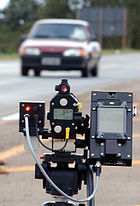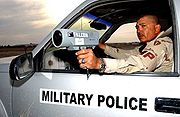
Radar gun
Encyclopedia

Doppler radar
A Doppler radar is a specialized radar that makes use of the Doppler effect to produce velocity data about objects at a distance. It does this by beaming a microwave signal towards a desired target and listening for its reflection, then analyzing how the frequency of the returned signal has been...
unit used to measure the speed of moving objects, including vehicle
Vehicle
A vehicle is a device that is designed or used to transport people or cargo. Most often vehicles are manufactured, such as bicycles, cars, motorcycles, trains, ships, boats, and aircraft....
s, pitched baseballs, runners and other moving objects. Radar speed guns may be hand-held, vehicle-mounted or static. A radar speed gun measures the speed of objects at which it is pointed by detecting a change in frequency of the returned radar signal due to the Doppler effect
Doppler effect
The Doppler effect , named after Austrian physicist Christian Doppler who proposed it in 1842 in Prague, is the change in frequency of a wave for an observer moving relative to the source of the wave. It is commonly heard when a vehicle sounding a siren or horn approaches, passes, and recedes from...
. Modern radar speed guns normally operate at X
X band
The X band is a segment of the microwave radio region of the electromagnetic spectrum. In some cases, such as in communication engineering, the frequency range of X band is rather indefinitely set at approximately 7.0 to 11.2 gigahertz . In radar engineering, the frequency range is specified...
, K
K band
K band designates certain portions of the electromagnetic spectrum, in either the microwave domain or in the infrared domain. The microwave K bands are used primarily for radar and satellite communications while the infrared K band is used for astronomical observations.-NATO K band:The NATO K band...
, Ka
Ka band
The Ka band covers the frequencies of 26.5–40 GHz. The Ka band is part of the K band of the microwave band of the electromagnetic spectrum. This symbol refers to "K-above" — in other words, the band directly above the K-band...
, IR Band (infrared), and (in Europe) Ku
Ku band
The Kμ band is a portion of the electromagnetic spectrum in the microwave range of frequencies. This symbol refers to —in other words, the band directly below the K-band...
bands.
They are frequently used for speed limit enforcement
Speed limit enforcement
Speed limit enforcement is the action taken by appropriately empowered authorities to check that road vehicles are complying with the speed limit in force on roads and highways. Methods used include roadside speed traps set up and operated by the police and automated roadside 'speed camera'...
although more modern LIDAR speed gun
LIDAR speed gun
A LIDAR speed gun is a device used by the police for speed limit enforcement which uses LIDAR to detect the speed of a vehicle. Unlike Radar speed guns which rely on doppler shifts to measure the speed of a vehicle these devices allow a police officer to measure the speed of an individual vehicle...
devices which use pulsed laser light instead of radar are more commonly used now. Some motorists install radar detector
Radar detector
A radar detector is an electronic device used by motorists to detect if their speed is being monitored by police or law enforcement using a radar gun. Most radar detectors are used so the driver can reduce the car's speed before being ticketed for speeding...
s which can detect signals from these devices to avoid being caught.
The radar speed gun was invented by Bryce K. Brown of Decatur Electronics in March 1954, and was first used in Chicago, Illinois in April 1954. Patrolman Leonard Baldy
Leonard Baldy
Leonard Frank Baldy was a Chicago Police Department officer who became the city's first helicopter traffic reporter. His sometimes comical look at Chicago's traffic problems made him a household name. His peers gave him the nickname "Flying Officer Leonard Baldy"...
was the first officer to issue a speeding ticket using the new device.
How radar speed guns work

Radar
Radar is an object-detection system which uses radio waves to determine the range, altitude, direction, or speed of objects. It can be used to detect aircraft, ships, spacecraft, guided missiles, motor vehicles, weather formations, and terrain. The radar dish or antenna transmits pulses of radio...
, consist of a radio transmitter
Transmitter
In electronics and telecommunications a transmitter or radio transmitter is an electronic device which, with the aid of an antenna, produces radio waves. The transmitter itself generates a radio frequency alternating current, which is applied to the antenna. When excited by this alternating...
and receiver. They send out a radio signal in a narrow beam, then receive the same signal back after it bounces off the target object. Due to a phenomenon called the Doppler effect
Doppler effect
The Doppler effect , named after Austrian physicist Christian Doppler who proposed it in 1842 in Prague, is the change in frequency of a wave for an observer moving relative to the source of the wave. It is commonly heard when a vehicle sounding a siren or horn approaches, passes, and recedes from...
, if the object is moving toward or away from the gun, the frequency
Frequency
Frequency is the number of occurrences of a repeating event per unit time. It is also referred to as temporal frequency.The period is the duration of one cycle in a repeating event, so the period is the reciprocal of the frequency...
of the reflected radio waves when they come back is different from the transmitted waves, and from that difference the radar speed gun can calculate the object's speed.
The target object's speed is proportional to the difference in frequency between the outgoing and the reflected radio waves. After the returning waves are received, a signal with a frequency equal to this difference is created by mixing the received radio signal with a little of the transmitted signal. Just as when two different musical notes are played together they create a "beat note
Beat (acoustics)
In acoustics, a beat is an interference between two sounds of slightly different frequencies, perceived as periodic variations in volume whose rate is the difference between the two frequencies....
" at the difference in frequency between them, when the two radio signals are mixed they create a "beat" signal (called a heterodyne
Heterodyne
Heterodyning is a radio signal processing technique invented in 1901 by Canadian inventor-engineer Reginald Fessenden where high frequency signals are converted to lower frequencies by combining two frequencies. Heterodyning is useful for frequency shifting information of interest into a useful...
) at the difference in frequency between the outgoing and reflected waves. The circuit then converts this frequency to a number by counting the number of cycles of the signal in a fixed time interval using a digital counter, and displays the number on a digital display as the object's speed.
It is important that the radio waves leave the gun in a narrow beam that doesn't spread out much, so that the gun will get a return only from the vehicle it is aimed at, with no chance of receiving a false return from nearby objects or vehicles. To create a narrow beam with an antenna small enough to fit in a handheld gun, radar speed guns use high frequency
Frequency
Frequency is the number of occurrences of a repeating event per unit time. It is also referred to as temporal frequency.The period is the duration of one cycle in a repeating event, so the period is the reciprocal of the frequency...
radio waves in the microwave
Microwave
Microwaves, a subset of radio waves, have wavelengths ranging from as long as one meter to as short as one millimeter, or equivalently, with frequencies between 300 MHz and 300 GHz. This broad definition includes both UHF and EHF , and various sources use different boundaries...
range. X band
X band
The X band is a segment of the microwave radio region of the electromagnetic spectrum. In some cases, such as in communication engineering, the frequency range of X band is rather indefinitely set at approximately 7.0 to 11.2 gigahertz . In radar engineering, the frequency range is specified...
(8 to 12 GHz) guns are becoming less common due to the fact the beam is strong and easily detectable. Also, most automatic doors utilize radio waves on X band and can possibly affect the readings of police radar. As a result K band
K band
K band designates certain portions of the electromagnetic spectrum, in either the microwave domain or in the infrared domain. The microwave K bands are used primarily for radar and satellite communications while the infrared K band is used for astronomical observations.-NATO K band:The NATO K band...
(18 to 27 GHz) and Ka band
Ka band
The Ka band covers the frequencies of 26.5–40 GHz. The Ka band is part of the K band of the microwave band of the electromagnetic spectrum. This symbol refers to "K-above" — in other words, the band directly above the K-band...
(27 to 40 GHz) are most commonly used by police agencies.
'Moving' radar speed guns
The above-described system measures the difference in speed between the target and the radar speed gun itself. The gun must be stationary to give a correct reading; if the gun is used from a moving car it just gives the difference in speed between the two vehicles. So a different system is used in radar speed guns designed to work from moving vehicles. In so-called "moving radar", the gun receives reflected signals from both the target vehicle and stationary background objects, such as the road, road signs, guard rails, streetlight poles, etc. Instead of comparing the frequency of the signal reflected from the target with the transmitted signal, it compares the target signal with the background signal. The difference in frequency of these two signals gives the true speed of the target vehicle.Traffic radar comes in many models. There are hand held, stationary and moving radar instruments. Hand held units are mostly battery powered, and for the most part are used as stationary speed enforcement tools. Stationary radar is mounted in police vehicles, and may have one or two antennae. These are employed when the vehicle is parked. Moving radar is employed, as the name implies, when the police vehicle is in motion. These devices are very sophisticated, able to track vehicles approaching and receding both in front of and behind the patrol vehicle. They can also track the fastest vehicle in the selected radar beam, front or rear.

